HOSPICE UK, which represents more than 200 hospices, raised the alarm in April last year about a £77-million deficit that the sector was facing.
Since then, the situation has got only worse, says the charity’s policy and public-affairs manager, Jodie Beck. Hospices now are “really on the brink”, she tells me. Two in five hospices in England are planning to cut their staffing or services. “At least 16” already have.
One example is Hospiscare, in Exeter, which serves an area of some 1025 square miles and receives 24 per cent of its funding from the NHS.
“We’ve got capacity for 12 beds,” the spiritual and supportive care lead, the Revd Lucyann Ashdown, says, “but we only run eight, because we can’t afford to run more. We have to make decisions day to day, based on our staffing levels. So, it might be that, instead of going out to see a patient, we do a video call with them.”
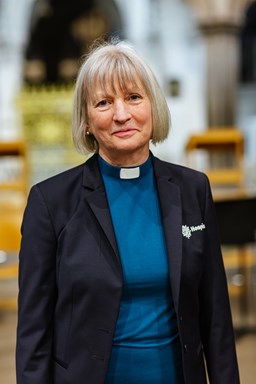 The Revd Lucyann Ashdown, spiritual and supportive care lead at Hospiscare, Exeter
The Revd Lucyann Ashdown, spiritual and supportive care lead at Hospiscare, Exeter
In England, the state meets on average about 40 per cent of hospices’ operating costs. Across the UK as a whole, the average is about 30 per cent. Otherwise, their work is funded by legacies, charity shops, jumble sales, and other fund-raising efforts, such as marathons and bungee-jumping.
The costs of maintaining and upgrading buildings and equipment, heating and lighting, are “surging”, Ms Beck explains. So are staffing costs, as hospices have to match pay rises in the NHS in order to compete for “the best of the best”, but don’t receive extra support from government to do so. At the same time, their charitable income has been stagnating as a result of the cost-of-living crisis.
Meanwhile, demand for palliative care is rising rapidly as the population ages. People are living longer, but also with much more complex health needs, Dr Rachel Black, chief executive of St Joseph’s Hospice, Hackney, in north-east London, says.
Today, if someone is diagnosed with cancer, for example, “there may be so many more treatments and so many different ways to keep them alive and well that their decline may be slower and more complicated, and involve more technology,” she says.
The Office for National Statistics has projected that, by 2030, there will be consistently more deaths in the UK than births. A 2023 report by Marie Curie suggests that, by 2048, the number of people dying in the UK will have risen by one quarter, and that as many as 90 per cent would benefit from palliative care.
A one-off injection of £100 million by the Government this year to meet capital costs was “a short-term fix”, Ms Beck says. “It doesn’t bring the hospice sector the long-term sustainability that it desperately needs. Time is running out.”
Already, she says, “far too many people don’t get the end-of-life care they need. One in four people who would have benefited from specialist palliative care don’t get it. Far too many die in hospital when they don’t need, or don’t want, to be there.”
PROFESSOR Jim McManus, a trustee of St Joseph’s who is also Public Health Wales’s national director of health and well-being, says: “As a nation, the UK hasn’t really taken the hospice movement seriously. We’ve seen it as a nice ‘free-to-have’ that exists to help the NHS in some ways. I think we’ve paid lip-service to hospice care in terms of national policy.”
The Nuffield Trust and the Health Economics Unit recently looked at health-care costs in the final year of life, and found that, of a total expenditure of £11.7 billion, £6.6 billion had been spent on emergency hospital care — “people going into hospital at the end of their lives because the care they need in the community is not available”, Dr Black says. Fewer than four per cent went to hospices, although it has been estimated that, across the UK, these currently support 260,000 people who are dying.
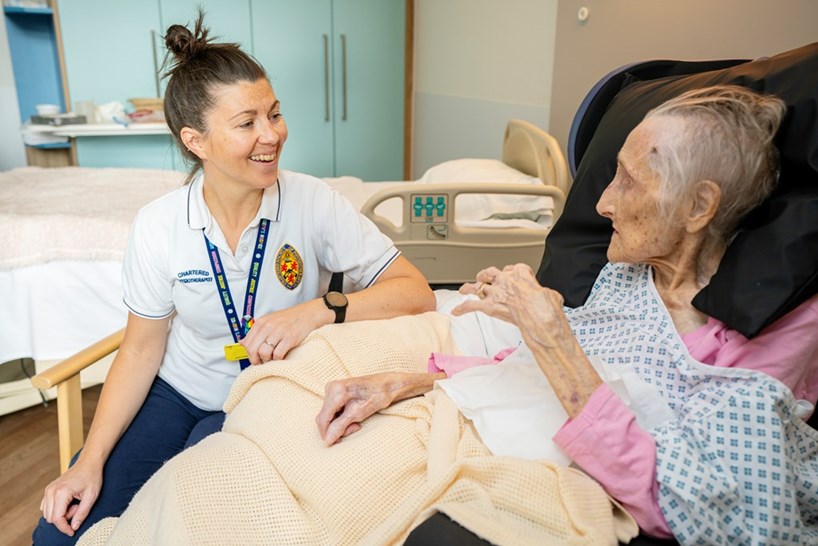 A patient is visited by a physiotherapist at St Joseph’s, Hackney
A patient is visited by a physiotherapist at St Joseph’s, Hackney
In purely financial terms, Professor McManus says, it makes sense to keep people out of hospital as they approach the end of their lives. Indeed, he says, one of the “big shifts” that the Government’s new 10-Year Health Plan for England proposes is “a move out of hospitals into community, because it’s better for people and it’s cheaper. That seems to be the Holy Grail.”
It is true that inpatient care in a hospice can be more expensive, because there is a higher staff-to-patient ratio, and there are no economies of scale, but, “when you add on the ‘opportunity costs’ of a hospital bed being taken up by someone who is waiting for an operation, [which might otherwise have to be] funded in the private sector, the economic case for hospices begins to stack up.”
Money is not the only consideration. He recalls that, when his mother was dying, in Scotland, in 2023,“we couldn’t get her a hospice place for love nor money, and she had to die in a hospital bed. Her pain could have been better managed. I ended up walking the wards at all hours of the day and night for the month she was dying.”
In fact, he says, in England it is an official aim of health policy to increase the proportion of people dying in their own homes, or a preferred place of death. “We have made limited progress in this, and the bulk of that progress has been because of the hospice movement. We need what the hospice movement does, absolutely, and the NHS would be worse off without it.”
THE “vast majority” of hospices’ work is done in the community, “and not just with people who are dying”, Margaret Doherty, centre lead of the Centre for the Art of Living and Dying Well, at St Mary’s University, Twickenham, says.
St Joseph’s, which was founded in 1905, now serves a population of 1.2 million people across four London boroughs. Today, it has 24 beds — fewer than in the past. “We have a large team that works in-house; so we have beds for overnight stays, and we also have a day hospice,” Dr Black explains. “There are hospitals all around us, and each has its own palliative-care team, and we work in partnership with those.
“We also have a large team in the community, and another big area of work around well-being and therapeutic support, social work, [and] enabling people to access benefits.”
Another service that St Joseph’s offers is “palliative rehabilitation”. “A lot of patients now will be diagnosed with a condition that they’re going to live with, with some deterioration, over the rest of their lifespan. So, someone might come into the hospice to stay for a week or two, and we’ll enable them to regain some skills, to maximise their independence.”
Recently, Dr Black recalls, “a gentleman came for a stay who was coming to the end of his life. He thought that people only came to us to die, and that was it; so it was a revelation to him that he could come in and be supported in this way, and he could leave in a better state than he came in.”
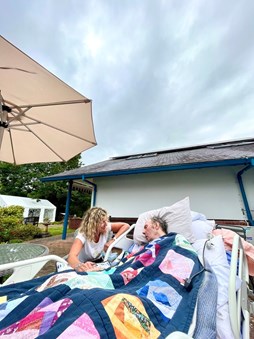 A Hospiscare patient, Mike, and his daughter in the garden in Exeter
A Hospiscare patient, Mike, and his daughter in the garden in Exeter
In the same vein, “a lady told me a couple of weeks ago: ‘The hospice has saved my life.’”
Hospices across the country are adopting a scheme, Compassionate Neighbours, which trains community volunteers to work with individuals in their own homes, “befriending them and sitting alongside them — some will do shopping, and some just do regular visits. We are thinking about how to reignite community,” Dr Black says. “How do we help people to understand the need of people who are at the end of their life, and how those around them might support them?”
Mrs Ashdown says that the holistic care that hospices provide, for both carers and the bereaved, “prevents them being unduly distressed, mentally and physically”. That includes spiritual care, for people of faith and none; emotional support, which might include counselling; complementary therapy; and “using our networks to connect people to their local communities, where they can forge new relationships, so that they don’t become over-dependent on us”.
St Joseph’s also uses its buildings to host other organisations. “A number of counsellors have rooms here; so we have a regular throughput of people who are receiving bereavement counselling. We also have an NHS lymphoedema clinic on site, with many people coming every day.”
Further afield, St Joseph’s has been commissioned to provide bereavement services for both adults and children. “That wraparound care is absolutely essential in making sure that we’re not just nurturing the individual patient, but looking out for the whole family.
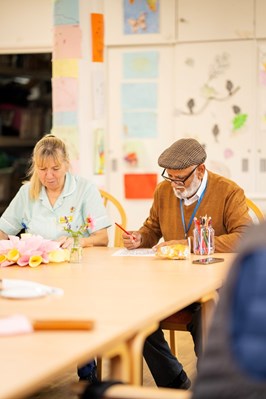 A nurse and patient in the day hospice at St Joseph’s, Hackney
A nurse and patient in the day hospice at St Joseph’s, Hackney
“When someone comes [to St Joseph’s to die], we’ll have large numbers of people in the room with that individual, making that space their own. We want to make this the best experience that they can have, given how sad it is for them.”
Professor McManus recalls an encounter that he had with a cleaner at the hospice, who was complaining about the quality of her mop. “She said to me: ‘I clean the floors in this place so that people die with dignity.’
“That has stuck with me to this day. When you walk the wards in our hospice, what hits you is love — and that is what the NHS should be about.”
Ms Doherty reflects: “How a person dies stays in the memories of those who live on. If people we love experience a good death, it helps us to come to terms with the fact that we ourselves are going to die — which gives us an opportunity to really live.”
FOR various reasons, provision of hospice care across the UK remains patchy, Ms Doherty says. For example, given how dependent hospices are on fund-raising, it is no surprise that they tend to be concentrated in more affluent parts of the country. “Depending on where you live, your experience of end-of-life care could be really quite different.
“On paper, that should not be so, because the Health and Care Act 2022 said that integrated care boards [ICBs] must commission sufficient palliative and end-of-life care; but we know that in practice that doesn’t always happen. The question is: what is the mechanism that can make sure that there isn’t such a postcode lottery?” She believes that more can be done “by using digital”.
Most people would prefer to die at home, she says. “A virtual ward enables just that, if your condition allows it — if you don’t have a high dependency on oxygen, say. It monitors your vital signs, and, if it detects that you are becoming more distressed, the medics come very quickly. It just gives you freedom to be where you want to be.”
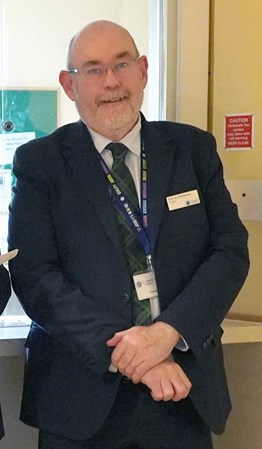 Professor Jim McManus, Public Health Wales’s national director of health and well-being, who is also a trustee of St Joseph’s Hospice, in Hackney, London
Professor Jim McManus, Public Health Wales’s national director of health and well-being, who is also a trustee of St Joseph’s Hospice, in Hackney, London
If the Government is looking for ways to make Britain healthier, Professor McManus says, “in my top ten would be proper palliative care, proper pain relief, and proper bereavement care as a package. The burden of mental ill-health that would reduce would be substantial.”
Hospice UK is asking the public to lobby their MPs for “fair funding” for hospices. “We want a long-term sustainable funding model so that they can continue to deliver care to the people that need it, and expand to meet the growing demand,” Ms Beck says. “We are going to be doing a lot of campaigning on this over the coming months, and any support for that really helps.”
Hospices should have “proper, really robust contracts” with their ICBs that fully cover the actual cost of delivering their specialist palliative-care services, and are regularly reviewed. At the same time, hospices should remain free to fund-raise for the specific services that they design to meet the particular needs of their local community and culture.
This is all the more important now that assisted dying is likely to become legal. “It would be intolerable to have a situation where assisted dying is in effect fully funded by the Government, whereas palliative and end-of-life care delivered by hospices has to be subsidised by jumble sales.”
There also needs to be accountability, Ms Beck says, “to make sure that palliative care is equitably provided, wherever you live and whoever you are”.
Dr Anna Dixon MP, the former co-chair of the Archbishops’ Reimagining Care Commission, agrees that “it is vital that we close the gaps” so that everyone can benefit from care to support them to have a good death.
If the assisted-dying Bill becomes law, she points out, “without consistent high-quality end-of-life care across the country, there is a risk that people will feel they have no real choice, and will seek to end their lives early rather than live every day to the full.”
She has been working with colleagues in Parliament to advocate increased funding for hospices, and also to ensure that ICBs are commissioning care in a way that ensures that everyone has the support they need in the most appropriate setting.
Are the authorities resistant to such an appeal? Ms Beck believes that it is “more a lack of understanding of the value of palliative and end-of-life care, of what hospices actually deliver, and why they’re important. It’s almost more a lack of understanding about death, and what dying well means.”

















